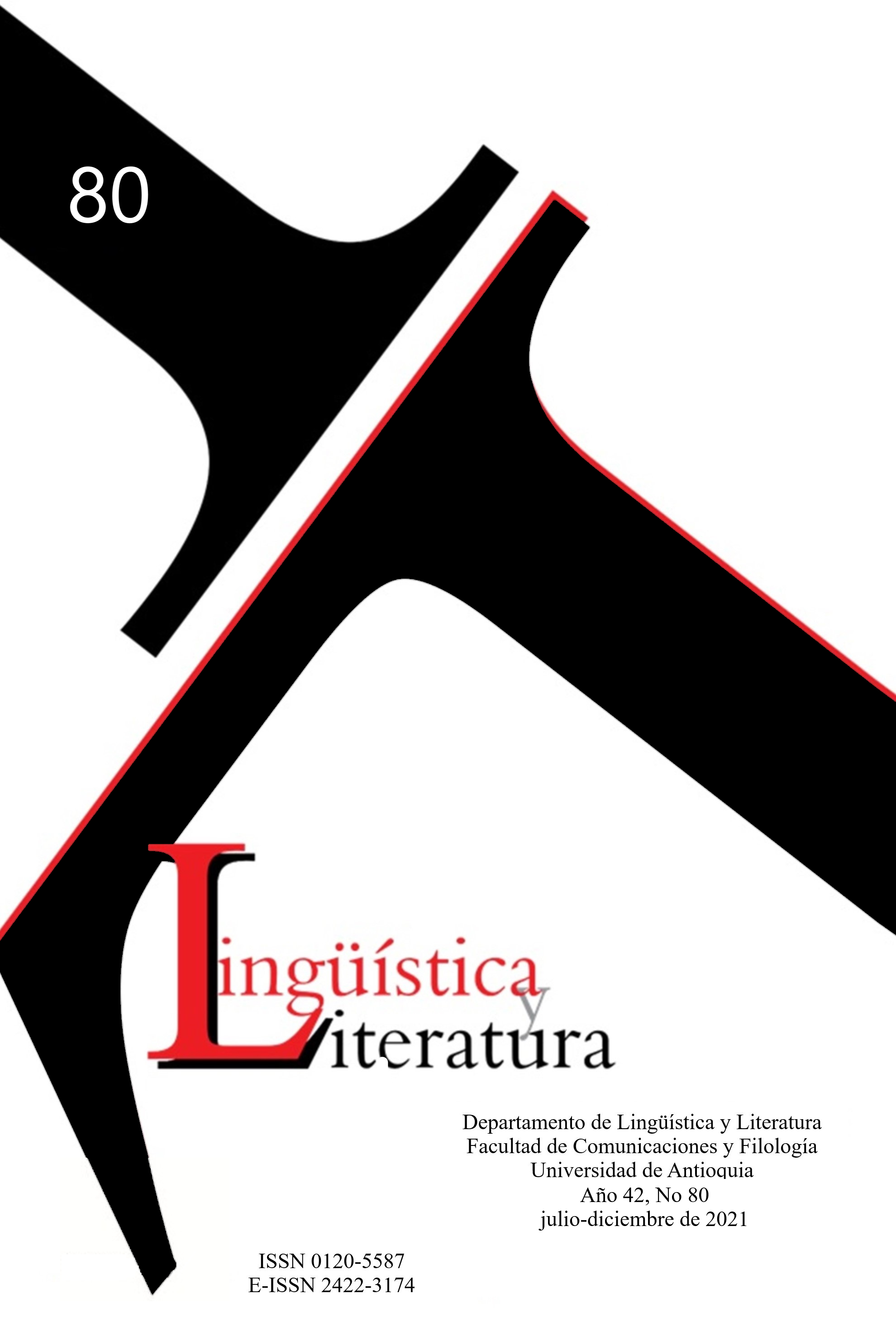Code-Switching en la interacción docente de una clase de lengua extranjera. Análisis de corpus en un entorno universitario argelino
DOI:
https://doi.org/10.17533/udea.lyl.n80a14Palavras-chave:
code-switching, análise do discurso, primeira língua, primeira língua estrangeira (L2), estudo de línguasResumo
Este artículo estudia el fenómeno del code-switching en un contexto de enseñanza de la lengua italiana en la Universidad de Annaba, en Argelia. Se examinarán determinados pasajes en italiano, árabe y francés hablados en Argelia y producidos principalmente por los profesores del departamento de lengua italiana, utilizando el análisis del discurso como modelo teórico. El estudio se centrará en las elecciones lingüísticas de los profesores en sus interacciones con los alumnos, tratando de comprender la naturaleza y las razones de la alternancia de códigos en el discurso. Esta contribución demostrará que la presencia frecuente de estas alternancias es necesaria para el proceso pedagógico.
Downloads
Referências
Allwright, R. (1984). The Importance of Interaction in Classroom Language Learning, Applied Linguistics, 5 (2), 156-171. https://doi.org/10.1093/applin/5.2.156
Anderson, L., (2003). Processi di commutazione di codice nella classe di lingua. En Ciliberti, A.; Pugliese, R. & Anderson, L. (Coords.). Le lingue in classe: discorso, apprendimento, socializzazione (pp. 75-91). Roma: Carocci.
Auer, P. (1995). The Pragmatics of Code Switching: A Sequential Approach. En Milroy, L. & Muysken, P. (Eds.). One Speaker, Two Languages. Cross-Disciplinary Perspectives on Code Switching (pp. 115-135). Cambridge: Cambridge University Press.
Canagarajah, A.S. (1995). Functions of Code-Switching in ESL Classrooms: Socialising Bilingualism in Jaffna. Journal of Multilingual and Multicultural Development (16), 173-195.
Castellotti, V. & Moore, D. (1997). Alterner pour apprendre, alterner pour enseigner, de nouveaux enjeux pour la classe de langue. Études de Linguistique Appliquée (108), 389-392.
Castellotti, V. (1997). Langue étrangère et français en milieu scolaire : didactiser l’alternance. Études de Linguistique Appliquée (108), 401-410.
Castellotti, V., (2014). L’hétérogénéité, fondement de l’éducation linguistique ? Vers des perspectives alterdidactiques. Glottopol (23), 173-190.
Danesi, M. (2000). Semiotics in Language Education. New York: de Gruyter.
Coste, D. (1997). Alternances didactiques. Études de Linguistique Appliquée (108), 393-400.
Ferroni, R. (2008). Esempi di alternanza di Codice nel discorso dell’insegnante e nella gestione delle attività. Supplemento Alla Rivista EL.LE, s.p. https://www.itals.it/esempi-di-alternanze-di-codice-nel-discorsodellinsegnante-e-nella-gestione-delle-attivit%C3%A0
Garabédian, M. & Lerasle, M. (1997). L’alternance codique. La double contrainte. Études de Linguistique Appliquée (108), 433-443.
Gumperz, J. (1982). Language and Social Identity. Cambridge: Cambridge University Press.
Ho, B. (1985), A Diary Study of Teaching EFL through English and through English and Chinese to Early Secondary School Students in Remedial English Classrooms. [Unpublished M. Phil. Thesis]. The Chinese University of Hong Kong. https://eric.ed.gov/?id=ED269984
Johnson, R.K. (1983). Bilingual Switching Strategies: A Study of the Modes of Teacher-Talk in Bilingual Secondary School Classrooms in Hong Kong. Language Learning and Communication, 2 (3), 267-283.
Legarreta, D., (1977). Language Choice in Bilingual Classrooms. TESOL Quarterly, 11 (1), 9-16.
Lin, A. M. Y. (1990). Teaching in Two Tongues: Language Alternation in Foreign Language Classrooms (Research Report nº 3). Hong Kong: Department of English, City Polytechnic of Hong Kong.
Long, M. H. (1996). The Role of the Linguistic Environment in Second Language Acquisition. In Ritchie, W. C. & Bhatia, T. K. (Eds.), Handbook of Second Language Acquisition (pp. 413-468). San Diego: Academic Press.
Littlewood, W. & Yu, B. (2011). First Language and Target Language in the Foreign Language Classroom. Language Teaching, 44 (1), 64-77.
Milk, R. (1981). An Analysis of the Functional Allocation of Spanish and English in a Bilingual Classroom. California Association for Bilingual Education: Research Journal, 2 (2), 11-26.
Triki, S.S. (2018). Insegnamento e diffusione dell’italiano lingua straniera in Algeria. Il Corriere di Tunisi, 181, 41-42.
Publicado
Como Citar
Edição
Seção
Licença
Copyright (c) 2021 Lingüística y Literatura

Este trabalho está licenciado sob uma licença Creative Commons Attribution-NonCommercial-ShareAlike 4.0 International License.
Creative Commons by-nc-sa
Aqueles autores/as que tenham publicações com esta revista, aceitam os seguintes termos:
1. A revista é o titular dos direitos de autor dos artigos, os quais estarão simultaneamente sujeitos à Licença Internacional de Atribuição-Não comercial-CompartilhaIgual 4.0 de Creative Commons que permite a terceiros compartilhar a obra sempre que se indique seu autor e sua primeira publicação esta revista.
2. Os autores/as poderão adotar outros acordos de licença não exclusiva de distribuição da versão da obra publicada (p. ex.: depositá-la em um arquivo telemático institucional ou publicá-la em um volume monográfico) desde que se indique a publicação inicial nesta revista.
3. Permite-se e recomenda-se aos autores/as difundir sua obra através da Internet (p. ex.: em arquivos telemáticos institucionais ou em sua página web) antes e durante o processo de envio, o que pode produzir intercâmbios interessantes e aumentar as citações da obra publicada.










